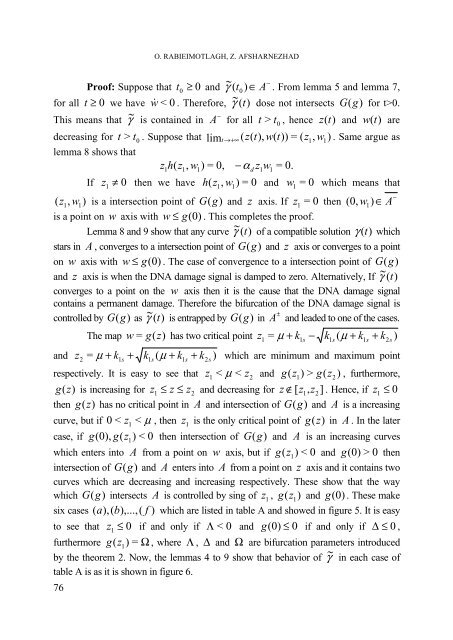biologia - Studia
biologia - Studia
biologia - Studia
Create successful ePaper yourself
Turn your PDF publications into a flip-book with our unique Google optimized e-Paper software.
O. RABIEIMOTLAGH, Z. AFSHARNEZHAD<br />
Proof: Suppose that t ≥ 0<br />
0 and ~<br />
−<br />
γ (t<br />
0)∈ A . From lemma 5 and lemma 7,<br />
for all t ≥ 0 we have w& < 0 . Therefore,<br />
~ γ ( t ) dose not intersects G (g)<br />
for t>0.<br />
This means that γ ~ is contained in<br />
76<br />
−<br />
A for all > t0<br />
t , hence z (t)<br />
and w (t)<br />
are<br />
decreasing for t > t0<br />
. Suppose that lim ( z ( t ), w ( t )) = ( z 1,<br />
w<br />
t → +∞<br />
1)<br />
. Same argue as<br />
lemma 8 shows that<br />
z h z , w ) = 0, − α z = 0.<br />
1<br />
(<br />
1 1<br />
d 1w1<br />
( z , w ) = 1 1<br />
If z 0 then we have h 0 and w = 0 which means that<br />
1 ≠<br />
( z , w 1 1)<br />
is a intersection point of G (g ) and z axis. If =<br />
−<br />
z<br />
1<br />
0 then (0, w<br />
1<br />
)∈ A<br />
is a point on w axis with w ≤ g(0)<br />
. This completes the proof.<br />
Lemma 8 and 9 show that any curve<br />
~ γ ( t ) of a compatible solution γ (t)<br />
which<br />
stars in A , converges to a intersection point of G (g)<br />
and z axis or converges to a point<br />
on w axis with w ≤ g(0)<br />
. The case of convergence to a intersection point of G (g)<br />
and z axis is when the DNA damage signal is damped to zero. Alternatively, If<br />
~ γ ( t )<br />
converges to a point on the w axis then it is the cause that the DNA damage signal<br />
contains a permanent damage. Therefore the bifurcation of the DNA damage signal is<br />
controlled by G (g)<br />
as<br />
~ γ ( t ) is entrapped by G (g)<br />
in<br />
±<br />
A and leaded to one of the cases.<br />
The map w = g(<br />
z)<br />
has two critical point z µ + k − k ( µ + k + k )<br />
1<br />
1<br />
=<br />
1s<br />
1s<br />
1s<br />
2s<br />
and z µ + k + k ( µ + k + k ) which are minimum and maximum point<br />
2<br />
=<br />
1s<br />
1s<br />
1s<br />
2s<br />
respectively. It is easy to see that z<br />
1<br />
< µ < z2<br />
and g ( z1)<br />
> g(<br />
z2)<br />
, furthermore,<br />
g (z) is increasing for z1 ≤ z ≤ z2<br />
and decreasing for z ∉ [ z 1,<br />
z 2]<br />
. Hence, if z ≤ 1<br />
0<br />
then g (z)<br />
has no critical point in A and intersection of G (g)<br />
and A is a increasing<br />
curve, but if 0 < z<br />
1<br />
< µ , then z<br />
1<br />
is the only critical point of g (z)<br />
in A . In the later<br />
case, if g (0), g(<br />
z1)<br />
< 0 then intersection of G (g)<br />
and A is an increasing curves<br />
which enters into A from a point on w axis, but if g ( z 1<br />
) < 0 and g (0) > 0 then<br />
intersection of G (g)<br />
and A enters into A from a point on z axis and it contains two<br />
curves which are decreasing and increasing respectively. These show that the way<br />
which G (g)<br />
intersects A is controlled by sing of z<br />
1<br />
, g ( z 1<br />
) and g (0) . These make<br />
six cases ( a ),( b),...,(<br />
f ) which are listed in table A and showed in figure 5. It is easy<br />
to see that z ≤ 1<br />
0 if and only if Λ < 0 and g (0) ≤ 0 if and only if ∆ ≤ 0 ,<br />
furthermore g ( z 1<br />
) = Ω , where Λ , ∆ and Ω are bifurcation parameters introduced<br />
by the theorem 2. Now, the lemmas 4 to 9 show that behavior of γ ~ in each case of<br />
table A is as it is shown in figure 6.
















